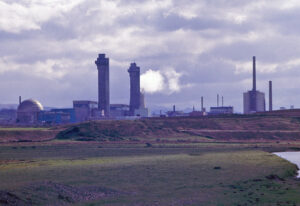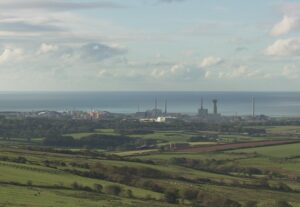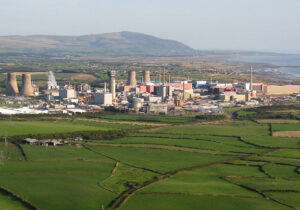 Sellafield, which was formerly known as Windscale Works, was an important multi-functional nuclear site located near Seascale on the coast of Cumbria, England. As of August 2022, its primary activities are the processing and storage of nuclear waste, along with decommissioning. Historically, the facility produced nuclear power from 1956 to 2003 and reprocessed nuclear fuel from 1952 to 2022. Originally built as a Royal Ordnance Factory in 1942, the site was briefly owned by Courtaulds for rayon production in the post-World War II years. Then in 1947, the Ministry of Supply reacquired it for plutonium production, leading to the construction of the Windscale Piles and the First-Generation Reprocessing Plant, and its renaming to “Windscale Works.” Significant developments followed, including the construction of Calder Hall, the world’s first commercial nuclear power station to supply electricity to a public grid, the Magnox fuel reprocessing plant, the prototype Advanced Gas-cooled Reactor (AGR), and the Thermal Oxide Reprocessing Plant (THORP). Decommissioning has been concentrated on the Windscale Piles, Calder Hall, and various historic reprocessing and waste storage facilities.
Sellafield, which was formerly known as Windscale Works, was an important multi-functional nuclear site located near Seascale on the coast of Cumbria, England. As of August 2022, its primary activities are the processing and storage of nuclear waste, along with decommissioning. Historically, the facility produced nuclear power from 1956 to 2003 and reprocessed nuclear fuel from 1952 to 2022. Originally built as a Royal Ordnance Factory in 1942, the site was briefly owned by Courtaulds for rayon production in the post-World War II years. Then in 1947, the Ministry of Supply reacquired it for plutonium production, leading to the construction of the Windscale Piles and the First-Generation Reprocessing Plant, and its renaming to “Windscale Works.” Significant developments followed, including the construction of Calder Hall, the world’s first commercial nuclear power station to supply electricity to a public grid, the Magnox fuel reprocessing plant, the prototype Advanced Gas-cooled Reactor (AGR), and the Thermal Oxide Reprocessing Plant (THORP). Decommissioning has been concentrated on the Windscale Piles, Calder Hall, and various historic reprocessing and waste storage facilities.
During its “Windscale Works” years, a severe fire broke out in the core of a nuclear reactor on October 10, 1957. As a result, significant radioactive material was released into the environment on October 10-11, 1957. Windscale Works was under the operation of the United Kingdom Atomic Energy Authority (UKAEA) at the time. On the 15th of October, the UKAEA Chairman announced the formation of an Inquiry Committee, chaired by Sir William Penney, to investigate the incident. The Committee convened at  Windscale Works from October 17–25th. They interviewed 37 individuals and reviewed 73 technical exhibits. They submitted their findings to the UKAEA Chairman on 26th October. These findings underpinned a UK Government White Paper (Command Paper 302), published on November 8, 1957. Oddly or perhaps criminally, the Penney Report itself remained unpublished until it was made available at The National Archives, Kew, in January 1988, basically covering up the event for decades. This event transpired when uranium metal fuel caught fire within Windscale Pile No. 1. The fire led to the release of radioactive contamination into the environment, which is estimated to have eventually caused approximately 240 cancer cases, with fatalities between 100 to 240. The incident received a level 5, on the International Nuclear Event Scale. The maximum rating is 7.
Windscale Works from October 17–25th. They interviewed 37 individuals and reviewed 73 technical exhibits. They submitted their findings to the UKAEA Chairman on 26th October. These findings underpinned a UK Government White Paper (Command Paper 302), published on November 8, 1957. Oddly or perhaps criminally, the Penney Report itself remained unpublished until it was made available at The National Archives, Kew, in January 1988, basically covering up the event for decades. This event transpired when uranium metal fuel caught fire within Windscale Pile No. 1. The fire led to the release of radioactive contamination into the environment, which is estimated to have eventually caused approximately 240 cancer cases, with fatalities between 100 to 240. The incident received a level 5, on the International Nuclear Event Scale. The maximum rating is 7.
Now called Sellafield, the licensed premises span 650 acres, housing over 200 nuclear facilities and more than 1,000 buildings. It stands as the largest nuclear site in Europe, boasting the world’s most varied array of nuclear facilities on a single site. Workforce numbers fluctuate, but prior to the COVID-19 pandemic, the site  employed around 10,000 individuals. The Central Laboratory and headquarters of the UK’s National Nuclear Laboratory are located on the premises. The site is owned by the Nuclear Decommissioning Authority (NDA), a non-departmental public body of the UK government. From 2008 to 2016, it was managed by a private consortium before control reverted to the government. Consequently, the Site Management Company, Sellafield Ltd, became a subsidiary of the NDA. The decommissioning process of the legacy facilities, which includes structures from the UK’s early efforts to develop an atomic bomb, is expected to be completed by 2120 at an estimated cost of £121 billion.
employed around 10,000 individuals. The Central Laboratory and headquarters of the UK’s National Nuclear Laboratory are located on the premises. The site is owned by the Nuclear Decommissioning Authority (NDA), a non-departmental public body of the UK government. From 2008 to 2016, it was managed by a private consortium before control reverted to the government. Consequently, the Site Management Company, Sellafield Ltd, became a subsidiary of the NDA. The decommissioning process of the legacy facilities, which includes structures from the UK’s early efforts to develop an atomic bomb, is expected to be completed by 2120 at an estimated cost of £121 billion.


Leave a Reply